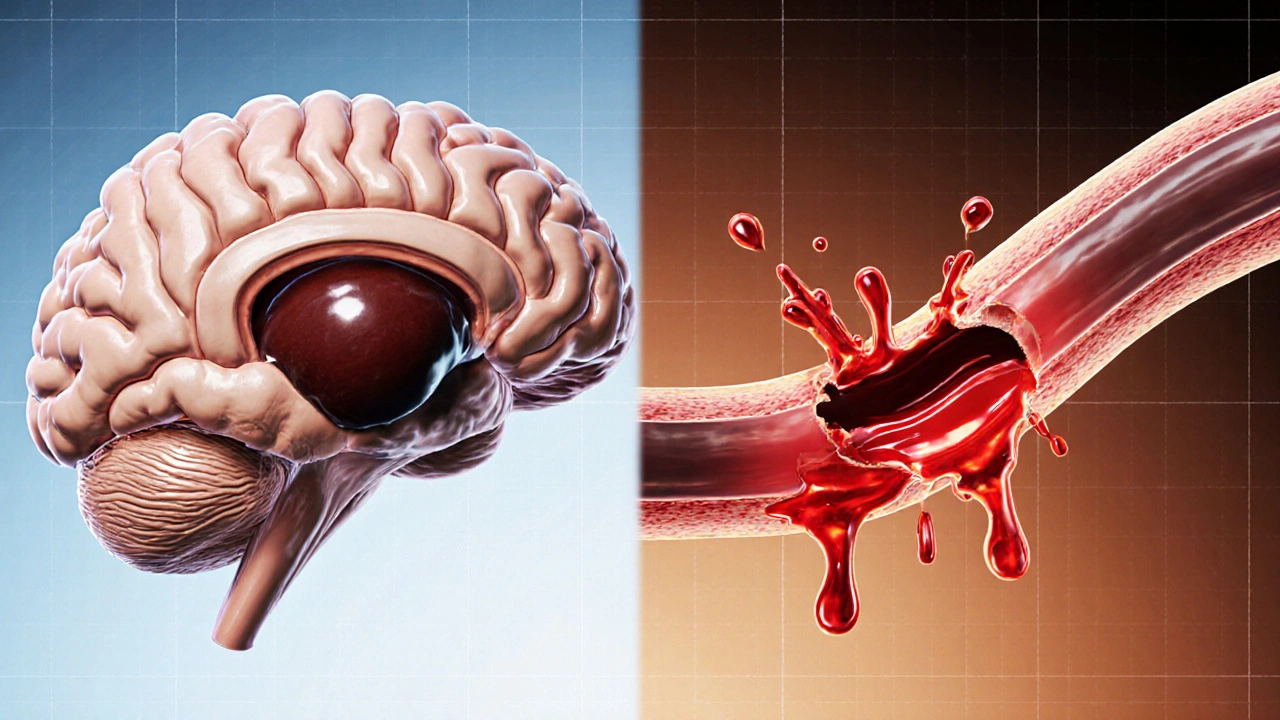Stroke Risk Assessment Tool
This tool helps estimate your stroke risk based on key modifiable factors. Please answer the following questions honestly:
Your Stroke Risk Assessment
Stroke is a medical emergency that occurs when blood flow to part of the brain is interrupted, either by a clot (ischemic) or a burst vessel (hemorrhagic). It can lead to permanent disability or death, but knowing the underlying causes dramatically lowers the odds of it happening. This guide breaks down the most common risk factors, explains why they matter, and shows practical steps to keep your brain safe.
Why Knowing the Risk Factors Matters
When you understand what pushes your odds higher, you can target those levers. Studies from the World Health Organization in 2023 show that more than 80% of strokes are linked to modifiable factors-meaning lifestyle changes or medical treatment can make a real difference.
Big Picture: Modifiable vs. Non‑Modifiable Risk Factors
| Category | Risk Factor | Typical Impact on Stroke Risk |
|---|---|---|
| Non‑Modifiable | Age | Risk doubles each decade after 55 |
| Non‑Modifiable | Gender | Men have ~1.5× higher risk; women’s risk rises after menopause |
| Non‑Modifiable | Family History / Genetics | First‑degree relatives increase risk by ~30% |
| Modifiable | Hypertension | Highest single risk factor; each 10mmHg rise adds ~30% risk |
| Modifiable | Smoking | Current smokers have ~2× higher risk; risk drops 50% after 5years quit |
| Modifiable | Diabetes | Type2 doubles stroke risk; tight glucose control cuts risk by ~15% |
| Modifiable | Atrial Fibrillation | Can increase risk up to 5‑fold if untreated |
| Modifiable | High Cholesterol | LDL >130mg/dL raises risk; statins lower risk by ~20% |
| Modifiable | Obesity | BMI ≥30 adds ~1.5× risk; weight loss >5% improves outcomes |

Deep Dive: The Top Modifiable Risk Factors
Below we unpack each factor, why it matters, and concrete actions you can take today.
1. Hypertension (High Blood Pressure)
Often called the "silent killer," hypertension exerts constant pressure on cerebral arteries, making them more prone to rupture or clot formation. The 2024 American Heart Association guideline recommends keeping systolic pressure below 130mmHg.
- Measure blood pressure at least weekly if you have a history.
- Adopt the DASH diet (rich in fruits, veggies, low‑fat dairy, and low sodium).
- Engage in 150minutes of moderate aerobic activity each week.
- If lifestyle changes aren't enough, discuss ACE inhibitors or ARBs with your doctor.
2. Smoking
Tobacco damages the inner lining of blood vessels, accelerates plaque buildup, and raises clotting factors. Even second‑hand smoke adds risk.
- Set a quit date within the next 30days.
- Use nicotine replacement therapy or prescription meds like varenicline.
- Seek support groups or quit‑line counseling (most free in NZ).
- Track triggers in a journal to avoid relapse.
3. Diabetes
High glucose levels impair the endothelium, fostering atherosclerosis. The 2025 New Zealand Diabetes Registry shows a 2.1‑fold increase in stroke incidence among uncontrolled patients.
- Aim for HbA1c <7% (individual targets may vary).
- Prefer low‑glycemic foods; monitor carbohydrate portions.
- Combine metformin with GLP‑1 agonists if weight loss is needed.
- Regular eye, kidney, and foot checks reduce overall vascular burden.
4. Atrial Fibrillation (AFib)
Irregular heart rhythm lets blood pool in the atria, forming clots that can travel to the brain. Anticoagulation (e.g., warfarin, DOACs) cuts stroke risk dramatically.
- Get an ECG if you experience palpitations, fatigue, or shortness of breath.
- Ask your clinician about CHA₂DS₂‑VASc scoring to gauge anticoagulation need.
- Consider rhythm‑control strategies (ablation, beta‑blockers) if symptomatic.
5. High Cholesterol
LDL cholesterol contributes to plaque that can block cerebral arteries. Statins not only lower LDL but also stabilize plaques.
- Target LDL <100mg/dL; <70mg/dL for high‑risk individuals.
- Include soluble fiber (oats, beans) and omega‑3 fatty acids.
- Discuss statin therapy with your GP; side‑effects are rare.
6. Obesity
Excess weight fuels hypertension, diabetes, and dyslipidemia-all stroke drivers. Even modest weight loss yields measurable benefit.
- Track daily calories using a phone app.
- Prioritize whole foods over processed snacks.
- Incorporate strength training twice weekly to preserve muscle mass.
Non‑Modifiable Factors: What They Mean for You
Age, gender, and genetics cannot be changed, but they help shape your risk profile.
- Age: After 55, the risk begins to rise sharply; after 75, it triples.
- Gender: Men experience strokes earlier; women face higher post‑stroke disability.
- Family History: If a parent suffered a stroke before 65, discuss early screening with your doctor.
Putting It All Together: Your Personal Stroke‑Risk Checklist
Use this simple worksheet to gauge where you stand. Mark ✅ if you meet the recommendation, ❌ if you need action.
| Risk Factor | Target Goal | Your Status |
|---|---|---|
| Blood Pressure | Systolic <130mmHg | ❓ |
| Smoking | Never / Quit | ❓ |
| HbA1c (if diabetic) | <130mmol/mol (≈7%) | ❓ |
| LDL Cholesterol | <100mg/dL | ❓ |
| Body Mass Index | 18.5‑24.9 | ❓ |
| Atrial Fibrillation Screening | ECG if >55y or symptomatic | ❓ |
Fill it out annually and bring it to your next health‑care visit. Your doctor can help you close any gaps.

When to Seek Immediate Care
Even if you’ve managed all risk factors, strokes can still happen. Recognize the FAST signs:
- Face drooping
- Arm weakness
- Speech slurring
- Time to call emergency services (999 in NZ)
Acting within the first three hours opens the door to clot‑busting medication, greatly improving outcomes.
Key Takeaway
Understanding the stroke risk factors gives you a roadmap to prevention. By tackling hypertension, smoking, diabetes, atrial fibrillation, cholesterol, and weight, you can cut your personal risk by more than half, even if age or genetics are on your side.
Frequently Asked Questions
Can a young adult have a stroke?
Yes. While risk climbs with age, conditions like congenital heart defects, severe hypertension, or illicit drug use can trigger strokes in people under 40. Early screening for high blood pressure and AFib is advisable if you have a family history.
How much does smoking increase stroke risk?
Current smokers have roughly twice the risk of an ischemic stroke compared with never‑smokers. Quitting for five years reduces the risk by about 50%, and after 10‑15 years the risk approaches that of non‑smokers.
Is diet really that important for stroke prevention?
Diet shapes blood pressure, cholesterol, and weight-all major stroke drivers. The Mediterranean and DASH diets have been shown in large RCTs to lower stroke incidence by 20‑30% over a decade.
Should I take aspirin daily to prevent stroke?
Aspirin is beneficial for people with a history of cardiovascular disease, but for primary prevention it can raise bleeding risk. Discuss with your GP; guidelines now recommend it only for selected high‑risk individuals.
What is the best way to check for atrial fibrillation?
A simple 12‑lead ECG or a 30‑second handheld ECG device can detect AFib. For intermittent symptoms, a 24‑hour Holter monitor or a wearable cardiac patch increases detection rates.


7 Comments
Sarah Seddon
Imagine your brain as a bustling city, its streets teeming with life‑blood, oxygen, and thoughts.
When the highways are clogged by high blood pressure, it’s like rush‑hour gridlock that can turn deadly in an instant.
That’s why mastering your BP is the crown jewel of stroke prevention – every millimeter of mercury matters.
Adopt the DASH diet, a rainbow of vegetables, low‑fat dairy, and a whisper of salt, and feel the pressure melt away like snow under the spring sun.
Flip the switch on sedentary habits; 150 minutes of brisk walking each week is your personal anti‑stroke shield.
Got a family history? Don’t let genetics be the puppet master – regular screenings and medication, when needed, keep you in the driver’s seat.
Smoking? Toss those cigarettes aside; each puff is a tiny bomb that singes your blood vessels, doubling stroke risk.
Look at quitting as a heroic quest, complete with nicotine patches, support groups, and a victory dance.
Diabetes? Tame that sugar rollercoaster with balanced meals and steady monitoring, because excess glucose erodes the inner lining of arteries.
Obesity? Shed even a modest 5% of body weight and watch your risk shrink dramatically.
Elevated cholesterol? Statins are the loyal guardians that patrol your blood, lowering LDL and rescuing you from plaque buildup.
Atrial fibrillation? This erratic heartbeat can hurl clots toward the brain, so anticoagulants are your safety net.
Stress? Practice mindfulness, deep breathing, or yoga – a calm mind translates to calmer vessels.
Sleep five to six hours? No, aim for seven to nine; restorative slumber heals, repairs, and keeps your cardiovascular system humming.
Remember, each positive change is a brick in the fortress protecting your most precious organ. Keep building, stay vigilant, and your brain will thank you for a lifetime of bright, vibrant moments.
Ari Kusumo Wibowo
Quit smoking now, the health gains are immediate.
Dominique Jacobs
Totally agree, dropping cigarettes is a game‑changer; you’ll notice your stamina bounce back within weeks, and the pressure on those arteries starts easing right away.
Plus, the risk of stroke begins to drop sharply after you’ve been smoke‑free for a few months, so there’s real, measurable payoff.
Channel that energy into a fresh routine – maybe a quick jog or a bike ride – and you’ll feel the difference in both body and mind. Stick with it, the benefits stack up fast.
Matt Tait
The article glosses over the fact that many people ignore hypertension because it’s “silent.” This complacency is dangerous and needs a reality check.
Matthew Ulvik
Great rundown! 😊 Keeping an eye on BP, weight, and smoking habits can really lower the odds. 👍
Mark Eddinger
The information presented is thorough and aligns well with current clinical guidelines. It appropriately emphasizes modifiable risk factors such as hypertension, smoking, and dyslipidemia.
Francisco Garcia
I find it useful that the guide breaks down each factor with concrete actions. For instance, the DASH diet recommendation for blood pressure control is spot on.